In this article, I explore the market in search of the best detective board games in 2023. There are several available, with a lot of similarities, but also differences.
After this article, you’ll have a pretty good idea of what is each of the detective board games about, its positives and negatives, and other crucial information.
Armed with this knowledge, cracking the case of which game suits you best, should be a breeze.
Table of Contents for Best Detective Board Games
| Image | Title (click for quick navigation inside the article) | Clues | Price |
|---|---|---|---|
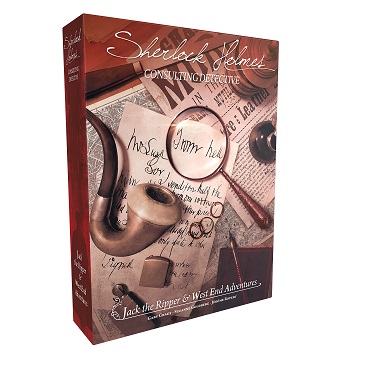 | Sherlock Holmes Consulting Detective | solving crime in Victorian times | $$ |
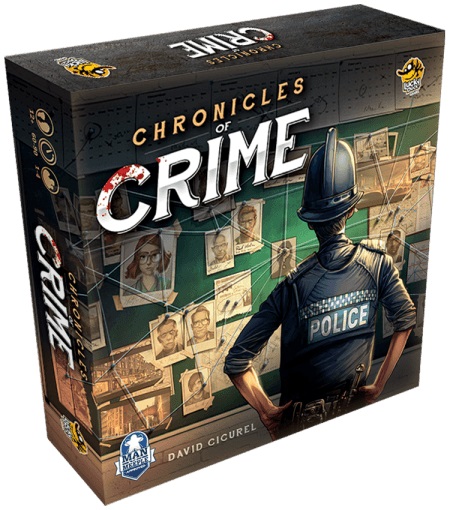 | Chronicles of Crime | solving crime with plenty of modern technology | $$ |
| Detective: A Modern Crime Board Game | solving crime with some use of technology | $$ | |
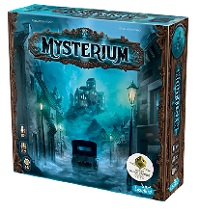 | Mysterium | a cooperative murder mystery with graphical clues | $$ |
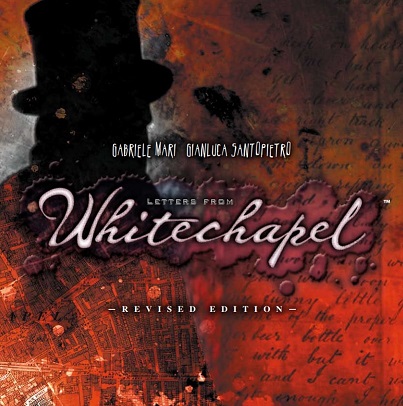 | Letters from Whitechapel and Whitehall Mystery | chase Jack the Ripper in hidden movement game | $$$ |
 | Awkward Guests | a more advanced version of Clue | $$ |
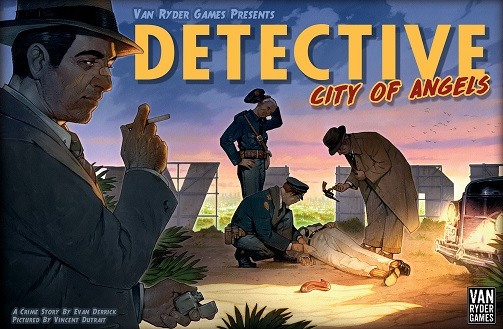 | Detective: City of Angels | do you know who inspector Columbo is? | $$$$ |
| T.I.M.E Stories | just like Groundhog day | $$ | |
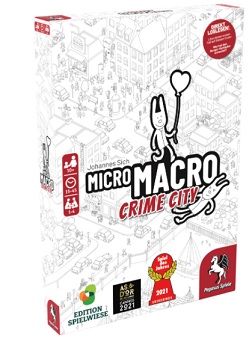 | MicroMacro: Crime City | find Waldo-ish | $$ |
| Conclusion | which games do I suggest? |
9. Sherlock Holmes Consulting Detective
Designers: Suzanne Goldberg, Gary Grady, and others.
Years published: 1982 onwards
Players: 1-8, best with 2
Playing time: 60-120 minutes
Complexity: medium

Story
It was the end of the 19th century, the height of the Victorian age. The world has become highly modernized and urbanized in a short time and London is at the center of a worldwide empire.
No wonder such a mix of working class, aristocracy, tradition, and modern technology fostered some of the more intriguing and unusual cases of criminal activity. Only a cunning detective like Sherlock Holmes, with his high attention to detail, could untangle such cases.
Game Mechanics
Sherlock Holmes Consulting Detective is novel-based. You read the case plot, related newspaper articles, and then you decide what places on the map to visit.
In each location, there is another article to read. You can visit the places in any order you please, re-visit them, and discuss the clues with your co-players.
Clue by clue, you will put the pieces of the puzzle together and when you’re confident enough that you have the solution to the case, you can read Sherlock’s solution. This will probably come as a small shock, realizing how many details you’ve missed compared to the famous detective.
As the number of cases is limited, rushing to the solution is highly unadvised. Instead, you should take all the time in the world – you can even come back the next day with a fresh mindset – trying to get everything right.
The narrative of the game is top-notch, the cases are interesting, diverse, and have a distinctly Victorian feel to them. You need an eye for details, because the solutions are typically Holmes-like, extrapolating plots from minor observations.
Editions and Expansions
Full games come with 10 cases each. They’re roughly linked with a story, so you’re advised to play the cases of each box in order.
- The Thames Murders & Other Cases (1982)
- Jack the Ripper & West End Adventures (2016)
- Carlton House & Queen’s Park (2017)
- The Baker Street Irregulars (2020)
Print and play free cases:
These two are hidden gems that I’ve come across in my research. Two mini-cases are available as a demo version of the main game. I highly recommend checking them out, because they give you a great feel for the main games and are completely free.
The Good
- Excellent cases, full of details.
- Great writing and atmosphere.
- Shines in co-op mode.
- Two cases are available for free.
The Bad
- Locations have very limited interaction possibilities. (read-only)
- You won’t like it if you don’t like Sherlock Holmes’s stories and ways of thinking.
Should you buy it?
Sherlock Holmes Consulting Detective is a great detective board game. If you’re a fan of classic detective stories and enjoy a good cooperative puzzle (perhaps with your spouse), this one is for you.
I suggest you try out the two free cases and then go with Jack the Ripper & West End Adventures.
8. Chronicles of Crime
Designer: David Cicurel
Year published: 2018
Players: 1-4, best with 2
Playing time: 60-90 minutes
Complexity: light/medium

Story
Chronicles of Crime takes place in modern-day London and incorporates modern techniques in crime-solving.
It’s a cooperative board game that relies heavily on the accompanying app and even uses your phone as a means to explore crime scenes.
Game Mechanics
As said Chronicles of Crime revolves around the app. You start by choosing one of the four scenarios (more are available as DLC) and the app does the rest.
It will tell you the narrative and details about the crime (location, people), and then it’s up to you to decide where to go and who to interrogate.
Interaction works by scanning QR codes that are on the cards of relevant people, locations, and items. You use the same technique when interrogating people about a certain item or a location – you simply scan its QR code.
When examing crime scenes, your device enters VR mode and you can pan it around and look for clues. It’s a very immersive experience that adds a lot to the overall fun factor of the game.
When you think you’ve solved the crime, you return to the police station and hand over the report. After you answer a few questions, the game will calculate your score, also based on the game time it took you to solve it.
Editions and Expansions
Chronicles of Crime: Noir and Chronicles of Crime: Welcome to Redview are two physical expansions. They introduce new scenarios, together with corresponding physical components (locations, items, and character cards).
For 2021, three more stand-alone games were announced as a part of The Millenium Series:
- Chronicles of Crime: 1400
- Chronicles of Crime: 1900
- Chronicles of Crime: 2400
Games will be set in Paris over the span of a millennium. You will follow the Lavel family, uncover the story, and solve mysteries.
The Good
- Very good integration of app and VR into board gaming.
- Well-designed and challenging cases.
The Bad
- It’s hard to get a good overview of the case in the app.
Should you buy it?
If you are a gamer that embraces innovation and appreciates mixing board games with video games, you will love Chronicles of Crime. It’s a great experience and a very good detective game.
On the other hand, if you’re an old-school brick-and-mortar player, you best steer clear.
7. Detective: A Modern Crime Board Game
Designers: Przemysław Rymer, Ignacy Trzewiczek, Jakub Łapot
Year published: 2018
Players: 1-5
Playing time: 120-180 minutes
Complexity: medium

Story
As the name suggests, Detective is set in a modern era. You play as members of the Antares National Investigation Agency in the US.
The game offers five different cases. You have to play them in order since they eventually reveal a larger story that unveils connections between them.
Game Mechanics
Detective: A Modern Crime Board Games uses a web app, called Antares database to help players set up the game and give them a backstory for the case.
As usual, it’s then up to the players to decide which leads to follow. Who and what to investigate and which trails are irrelevant to the case. Separating seeds from the chaff is very important since there is just not enough time to follow every lead.
Following a lead costs time and there are only 8 working hours in a day, so you have to choose carefully. You can work overtime, but that causes stress to your character and can cause you to lose the game.
You solve crimes the old-fashioned way – by using notes and making connections between clues. Often you will need to use the Antares database to search deeper. The game goes one set further: for certain cases, you must expand your search onto Google!
When the crime is solved, you give in your final report and fill out a questionnaire in the Antares database. The game will then calculate your result.
Although Detective: A Modern Crime Board Game is not a legacy game, the five cases lead one into the other and progress the rich story. It’s well-advised you play all of them with the same group of players or they just won’t have a clue what is going on.
Editions and Expansions
Several additional scenarios are available:
- Case 6: Suburbia (2018) – 1 case.
- Stand-Alone Case: Natural Causes (2019) – 1 case.
- L.A. Crimes (2019) – 3 case campaign.
- Signature Series: Dig Deeper (2020) – 1 case.
- Signature Series: Petty Officers (2021) – 1 case.
On top of that, in 2020 Detective: A Modern Crime Board Game – Season One was released. This is a legacy game, consisting of 3 cases.
Vienna Connection was released in 2021. Inspired by Detective, it features similar game mechanics, but it’s set in Vienna in 1977. Players will take on the roles of CIA agents in the middle of the Cold War.
The Good
- Strong theme and smooth game mechanics.
- Just the right amount of app usage.
The Bad
- Can be a real brain-burner.
Should you buy it?
Detective: A Modern Crime Board Game is one of the best detective board games. The amount of modern technology usage is right about perfect, the cases are diverse and interesting, and the story is immersive.
The game is very challenging. It does not hold you by the hand – you have to figure out the relevant clues yourself and where to go next. Just like a real detective.
6. Mysterium
Designers: Oleksandr Nevskiy, Oleg Sidorenko
Year published: 2015
Players: 2-7, best with 5-6
Playing time: 45 minutes
Complexity: light/medium

Story
When Mr. MacDowell, a talented astrologer, bought a new house, he detected the presence of a supernatural being, a ghost. Quickly he gathered his friends, also mediums, and they tried to communicate with the ghost.
Soon they learned that it was a ghost of a man, who was murdered and that the murder is, to this day, still unsolved. The ghost is trying to communicate with them, but he has trouble communicating – in fact, he has trouble even remembering the tragic evening. Will you be able to help him and solve the mystery of his murder?
Game Mechanics
Mysterium is an asymmetric cooperative game. One of the player plays as a ghost of a murdered man, while other players play as mediums, communicating with him. The objective of the game is to find the victim’s killer, his weapon, and the location of the murder so that the ghost can rest in peace.
But the ghost cannot speak directly, he can only give out clues (cards) to players. In a series of rounds, players try to put together the clues, and if, in the end, the majority guesses correctly, the ghost is saved.
The cards are filled with different illustrations, often very abstract. They can be interpreted in different ways and knowing your fellow players and how they will interpret something is key. No talking from the ghost is allowed. The players can (and must) talk and discuss between them, of course.
In a way, it’s similar to Dixit (when it comes to the cards and how they are used), but as players work together, Mysterium offers a far superior experience.
It’s also very replayable. There are a lot of different cards, the solution is different every time, and everyone wants to play as the ghost eventually.
Game rules are easy to understand and easy to learn. The hardest part is playing the ghost, as it has a direct influence on the quality of the game and the enjoyment of other players. Putting the most experienced player as the ghost is advised.
For the optimal experience, the game requires more players than usual. Four (3+1) is the absolute minimum, 5 or 6 seems to work best.
Editions and Expansions
- Tajemnicze Domostwo (2013) is the original title of the game when it was first released. If you come across it, you can buy it without hesitation, as the gameplay is text-free and completely language-independent.
- Mysterium Park (2020) is a sequel, that was released at the end of 2020. It introduced a new plot (circus), new cards, and revised game mechanics.
Two larger expansions have been released:
- Mysterium: Hidden Signs (2016)
- Mysterium: Secrets & Lies (2017)
They introduce new characters, locations, items, and story cards. On top of these, several smaller packs or promo packs of story cards have been released.
The Good
- Unique idea.
- Brilliant artwork on the cards.
- Playing as a ghost.
The Bad
- Doesn’t work well with low player numbers.
Should you buy it?
If you’re looking for something different and you often play in larger groups, Mysterium will not disappoint you. It combines abstract-art clues with cooperative play into one of the most remarkable murder mystery board gaming experiences.
5. Letters from Whitechapel and Whitehall Mystery
Designers: Gabriele Mari, Gianluca Santopietro
Year published: 2011
Players: 2-6, best with 2
Playing time: 60 minutes
Complexity: medium
Story
Letters from Whitechapel revolves around Jack the Ripper, one of the most notorious serial killers in history. It’s set in the Whitechapel area, which is depicted beautifully on a map with 199 numbered locations.
One of the players plays as Jack, trying to take down five victims and make it safely back to his hideout, before other players, police detectives, catch him.
Game Mechanics
Hidden movement is the prevalent game mechanic in Letters from Whitechapel.
Each night, Jack secretly marks one of the possible murder locations. Detectives also secretly mark their deployment. After the murder is committed and Jack heads back to his hideout, the chase is on.
Jack’s movement is tracked on a hidden board, that only the Jack player can see. Investigators will seek clues by asking him about location numbers.
They will try to follow Jack and when they’re sure they’re in the same location as him, they can declare an arrest and win the game. If they guess incorrectly, their turn is over.
Jack has to get back to his hideout in 15 moves or he loses. He has some special moves though: he can double move using carriages, pass through investigators, or use back alleys.
Catch me if you can
These ingredients produce tense gameplay. Players (especially Jack) will bluff and double bluff, trying to lead the detectives onto the wrong path.
Investigators will work together to deduct Jack’s movement and hideout, trying to encircle him. They will observe his poker face, looking for flinches as they mention certain locations.
Game mechanics are very simple, making this game easily accessible to casual players and families, yet they allow for a lot of depth, variety, and replay value. The locations are different each time, and of course, everyone wants to play as Jack eventually.
Editions and Expansions
Letters from Whitechapel: Dear Boss (2017) is a small expansion that adds player power cards, suspect cards, and plastic miniatures. It adds atmosphere but is not essential.
Whitehall Mystery (2017) is a standalone game. The theme is similar (although the artwork is changed); one player plays as the murderer, while others are chasing him. Game mechanics are revised and condensed, making for even tenser gameplay. That also makes for slightly shorter game time.
There are mixed opinions about whether Whitehall Mystery is better than Letter from Whitechapel. They are similar interpretations of the same game with only slight modifications.
The Good
- Simple to play.
- An immersive and tense game of outwitting your opponent.
The Bad
- Some might not like the thematic implication of playing as Jack the Ripper.
Should you buy it?
Letters from Whitechapel and Whitehall Mystery are both excellent hidden movement games. If hide-and-seek was your favorite game as a kid, you will love the experience they provide.
While the original is excellent, Whitehall Mystery is also recommended if you seek a more condensed experience with revised game mechanics.
4. Awkward Guests
Designer: Ron Gonzalo García
Year published: 2016
Players: 1-8, best with 4
Playing time: 45-75 minutes
Complexity: light/medium

Story
Mr. Walton has been murdered. You and several other investigators find yourself in a 1920’s style mansion and your job is to find the murderer, weapon, and motive.
Game Mechanics
Awkward Guests is a deduction game where players trade clues and compete against each other as to who will be the first one to guess all three unknowns. But beware! Guess incorrectly and you are eliminated from the game!
The setup allows for 3600 different scenarios, so the replay factor is high. You can also adjust the difficulty. Each case setup requires 70 cards, which you must acquire from the larger 243-card deck. This process can be a bit tedious, but it’s a one-time job per case.
Each player is dealt six clue cards that he keeps hidden behind a screen. There he also has a cheat sheet (rules overview) and a personal notebook in which he records the clues.
Notebook sheets are prepared in advance – they feature a map of the mansion, motives, weapons, and culprits and you can mark your findings easily.
Clues
Clue cards are a crucial part of solving a case. They have values 1, 2, and 3, depending on how much information they give out. A value 1 card will give you only vague information on where the suspect may have been, while a value 3 card will be much more specific.
But six clue cards are nowhere near enough to solve a case. Therefore, players trade clue cards during several phases. The active player will ask about certain unknowns and other players will offer him cards to trade. When you decide to trade, you must always offer more value than you receive.
As players receive new clues, they will mark their findings on their sheets. When all the players have traded, a round ends, and players discard down to three cards. Then they draw three new cards.
The process continues until someone cracks the case or all players are eliminated.
Simple, yet so complicated
As you can see, the rules are very simple, yet Awkward Guests is a big brain burner and a brilliant game, namely because of trading.
Each time you trade, you give some information away. You don’t want to give out too much (you might hold the strongest clues in your hand the whole game), but if you never offer anything useful, no one will trade with you.
The clues give out precise information, which you then mark on your sheets. But there is so much more imprecise information available by studying other players. Why are they offering me this powerful clue? Are they hiding something more valuable?
Player B never wants to trade with player C – do they know something we don’t? You have to get into their heads. Bluffs and double-bluffs are common.
The higher the difficulties, the less clear the clues are, and the more you have to rely on imprecise information and deduction. To spice things up, on higher difficulties, you also have to guess the accomplice.
The Good
- Very simple rules.
- High replay value.
- A lot of freedom in your approach (to trade or not to trade?).
The Bad
- Can be a real brain-burner, especially at higher difficulties.
Should you buy it?
Awkward Guest is the one board game on our list most closely related to Clue(do). The classic game leaves much to be desired, but Awkward Guests replies with a bang.
It’s everything Clue should be and much more. It’s one of the best competitive deduction games, particularly suitable for larger groups.
3. Detective: City of Angels
Designer: Evan Derrick
Year published: 2019
Players: 1-5, best with 3
Playing time: 30-150 minutes
Complexity: light/medium

Story
Los Angeles, 1940s. You’re a cynical detective, solving crimes in a grim and merciless city.
Put your trenchcoat on and light yourself a cigarette, because this is as noir an experience as board games can offer. And beware of the beautiful ladies, because they bring nothing but trouble!
Game Mechanics
Detective: City of Angels is a highly narrative game without complex game mechanics. There are rules, of course, but the game’s focus is elsewhere.
It puts you in the shoes of a detective and it accomplishes that with style. Immersion is epic: the artwork and written material (with some voice-over!) are right out of the 40’s movie scene.
The game offers three modes:
- competitive against the Chisel (game master),
- cooperative against the Chisel,
- or cooperative against the AI case notebook (Sleuth mode).
While the first two modes are fine, they require someone to play as the Chisel. Moreover, he has a very responsible job and can even ruin a game if he so pleases. The competitive play also keeps players to themselves, which makes the experience a bit lonely.
The third mode is where the game really shines. Players now debate and work together (although they still play their own detective on the map), which lifts the game to another level. It brings the game away from the board, into the minds and mouths of the players.
Whatever mode you play, there will be crimes that need solving – 9 cases are included with the base game. You have many options on how to approach them – you will travel the map (which is a work of art), uncover the evidence, and interrogate suspects.
Interrogating suspects
But the suspects are a very slimy bunch. Sometimes they will tell the truth, but often they will lie and try to put you off the trace.
Interrogations are a very important part of the game and there is a lot of written material just for that. Adaptive response cards are used, meaning you have interactive options during the interview and you can get different responses depending on how hard you press. It’s not just read-only.
You don’t have infinite time to solve a case. You have to weed out information from the suspects and connect it with the clues. There is no system to do this and often you will have to rely on your gut feeling and make an educative guess before the case turns cold.
The Melancholy and the fatalism of the noir movies are well portrayed by this.
Editions and Expansions
Two expansions are available. They add new cases.
- Detective: City of Angels – Bullets over Hollywood (2019)
- Detective: City of Angels – Smoke and Mirrors (2020)
The Good
- Immersive noir experience.
- Strong narrative.
- Interactive interrogations.
The Bad
- Only 9 cases in the base game.
Should you buy it?
Detective: City of Angels is kind of a hidden gem among detective board games. The theme and story are strong and so is the detective part.
It works well with all player numbers (even solo) and the only holdback I can see is if you don’t like the noir theme.
2. T.I.M.E Stories
Designers: Peggy Chassenet, Manuel Rozoy
Year published: 2015
Players: 2-4, best with 4
Playing time: 90 minutes
Complexity: light/medium
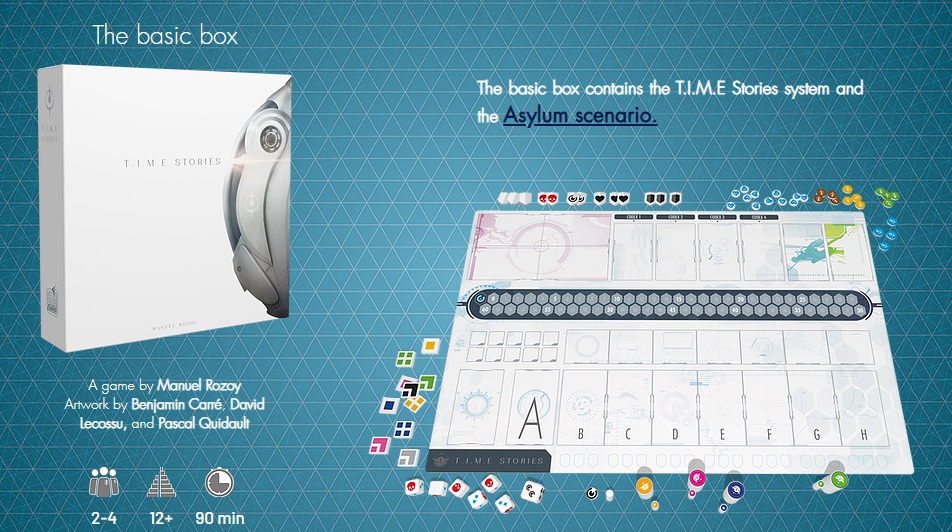
Story
In TIME Stories, you play as temporal agents, who are sent back in time to complete a specific mission or an investigation. What makes the game special is, that you are almost guaranteed to fail the first time you try.
But don’t give up, because you will have another go at it, now with using the already acquired knowledge. Fail again and the process repeats itself until you succeed. You’ve seen Groundhog Day with Bill Murray, have you?
Game Mechanics
The base game comes with only one case (Asylum), so you don’t have a lot of options for the setup. You assume the role of a unique character and read the mission briefing.
The rest of the cooperative experience is up to you. Missions come with a panoramic map of cards onto which your characters move and explore. You can examine a card location, move to another location, perform tests (using dice), or do nothing.
By performing these actions, you discover new locations, clues, items, and solve puzzles. But every action you do costs a certain amount of time units. If you run out of them, the mission is lost and you can try again from the setup phase.
TIME Stories offers a great experience. The cases are well-written, the tension with those time units is ever-present and players must work and think together which creates a great atmosphere. Especially when you play the same case several times and you already know certain things, meaning you have a lot more room to deduct.
But greatness comes with a few drawbacks. It’s advised to replay the case with the same group of players (because of the knowledge they acquired on the former runs). With a quite long playtime (realistically you will play only one game per evening) and four-player being the ideal player count, this is sometimes hard to achieve.
Next, there is no replay value for the cases you already solved. OK, with the re-runs, a single case can last several evenings, but 6 hours of gameplay for the only case in the base game is low either way. There are numerous expansions (additional cases) available, but the pricing is quite steep.
And then there are the dice. I understand they are included to create some extra tension, but it’s no fun when you have everything about a case mastered and you fail because of bad luck.
Editions and Expansions
The so-called White Cycle is a collection of cases, that are connected by an overarching story. They were released from 2015 to 2019:
- T.I.M.E Stories (base game)
- T.I.M.E Stories: The Marcy Case
- T.I.M.E Stories: A Prophecy of Dragons
- T.I.M.E Stories: Under the Mask
- T.I.M.E Stories: Expedition – Endurance
- T.I.M.E Stories: Lumen Fidei
- T.I.M.E Stories: Estrella Drive
- T.I.M.E Stories: Brotherhood of the Coast
- T.I.M.E Stories: Madame
On top of these, several fan-made cases are available, but these come with questionable quality.
After 2019, the Blue Cycle of expansions, TIME Stories Revolution, began to release.
The Good
- Unique concept.
- Engaging and highly immersive missions.
- Cooperative play.
The Bad
- No replay value and a high price tag for expansions.
Should you buy it?
Despite its shortcomings, T.I.M.E Stories is a unique and unforgettable experience. I believe every board game detective should try it out. Just beware that you will become hooked and will want the expansions as well!
1. MicroMacro: Crime City
Designer: Johannes Sich
Year published: 2020
Players: 1-4, best with 2
Playing time: 30 minutes
Complexity: light

Story
Welcome to Crime CIty, a giant 75x110cm (30×43 inches) black and white stylized map, full of streets, buildings, cars, people, events … and crime. There are 16 cases for you to solve. You’ll need a perceptive eye and attention to detail. Oh, and a magnifying galls will be useful, as well.
Game Mechanics
Each case is presented as a deck of cards. You task is to explain the events by finding the clues, culprints, and evidence on the map. While the map is physically static, the events are pictured in several stages. For example, you’ll see a victim walking down the streets, then a few blocks down, he’s pictured buying an icecream, on the next street, he lies, murdered.
You’ve got to follow the trail and figure out what happened by answering severeal questions. How many of them you aswered correctly will determine your success. So make sure you don’t miss anything.
Editions
In 2021, MicroMacro: Crime City – Full House with 16 new scenarios was published. It has another advantage – the cases are now marked with symbols for suitabilitly with kids. The concept of the original game was perfect for playing with the young ones, the only problem was that you don’t wan’t your kid to find a corpse. Now, you can select the cases appropriate to age.
The Good
- Easy to play.
- Great fun for the whole family.
- Brilliant concept.
- Cheap.
The Bad
- No replay value.
Should you buy it?
MicroMacro is a great game and it’s no wonder it was on every top list of 2020. Now, with the Full House edition being more suitable for families, there’s absolutely no excuse to not get it.

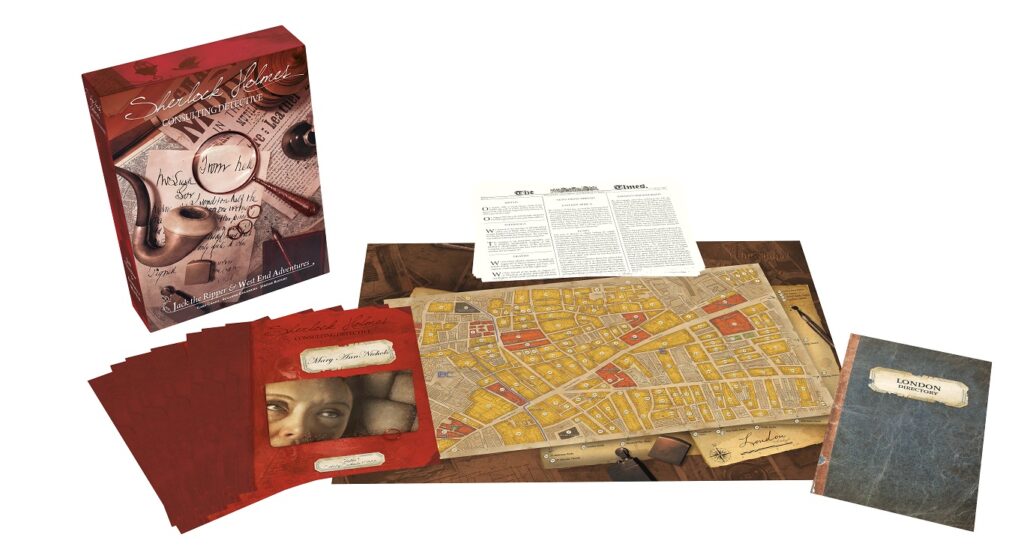
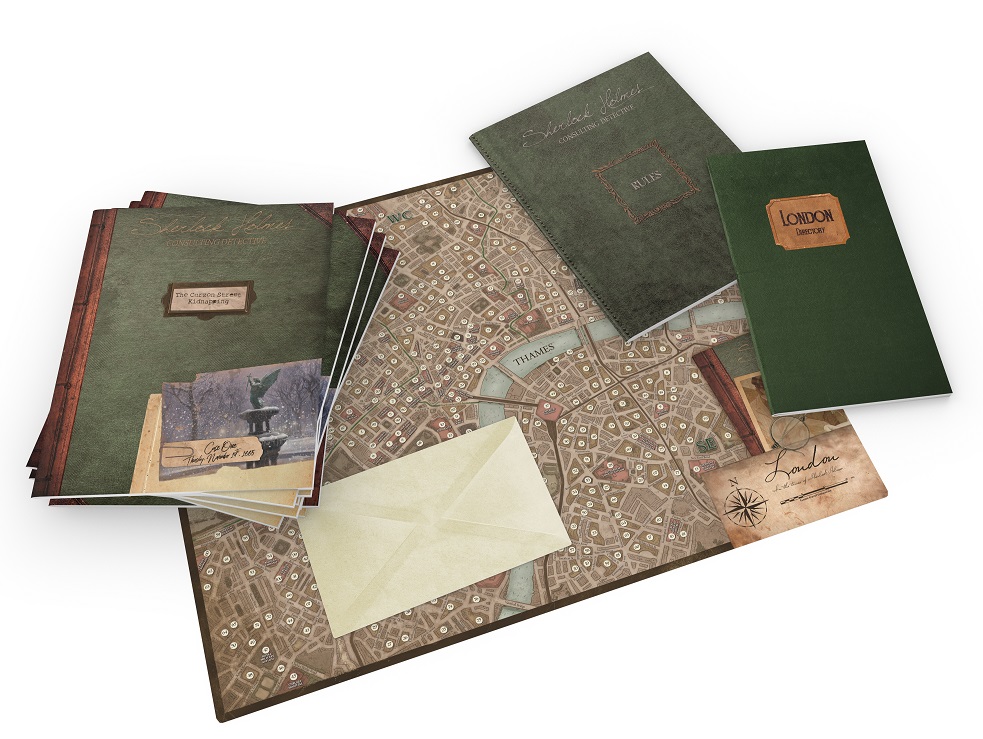
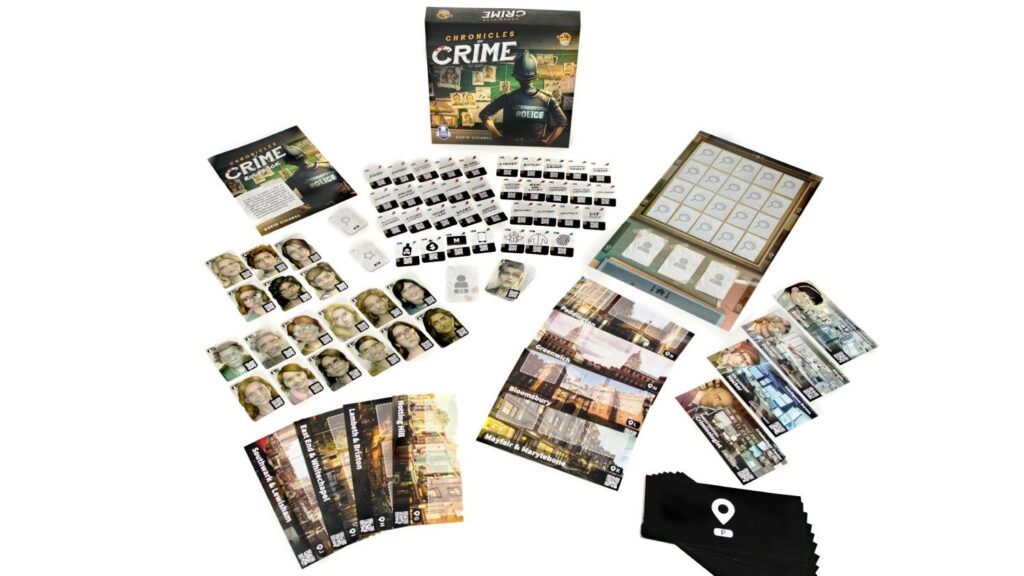
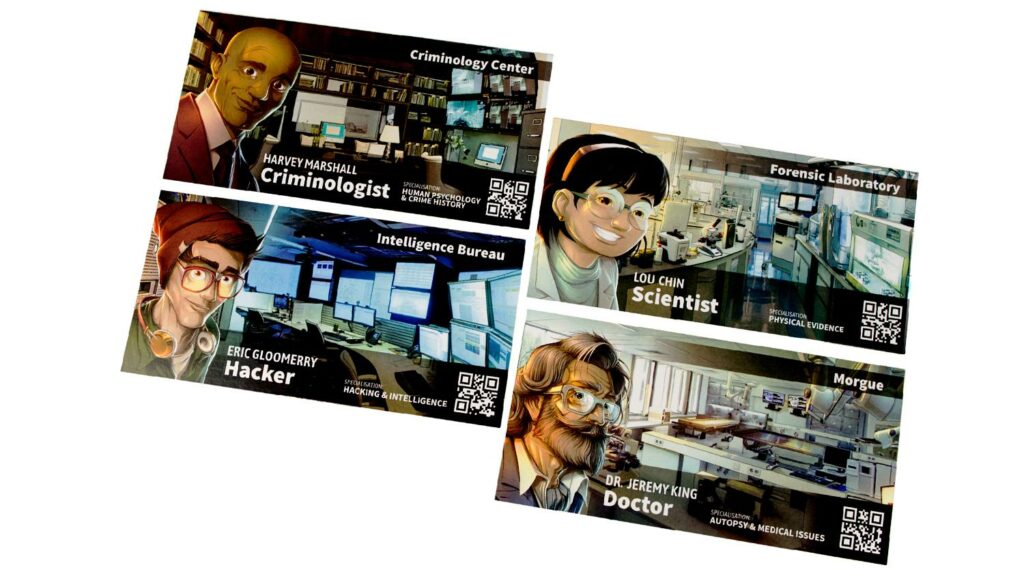
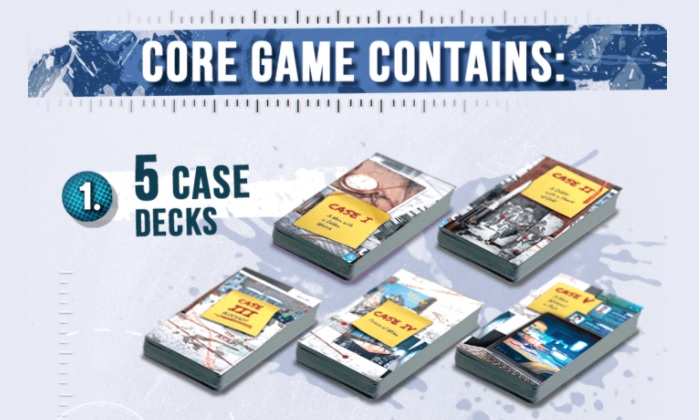
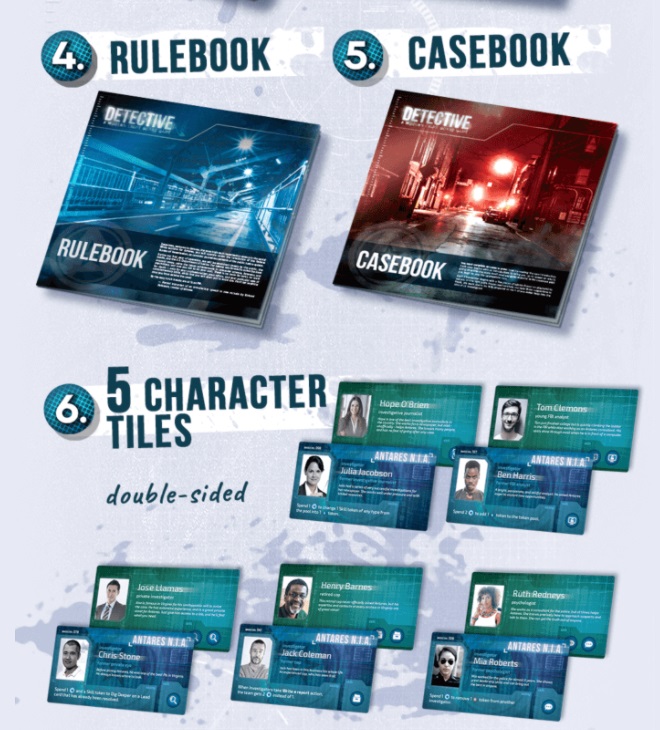
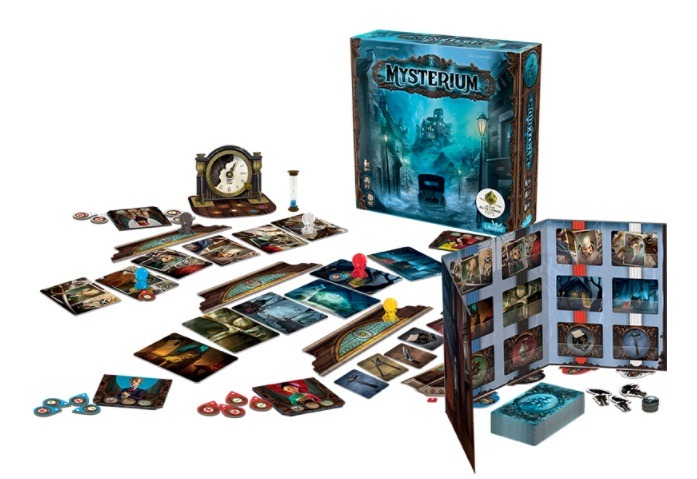
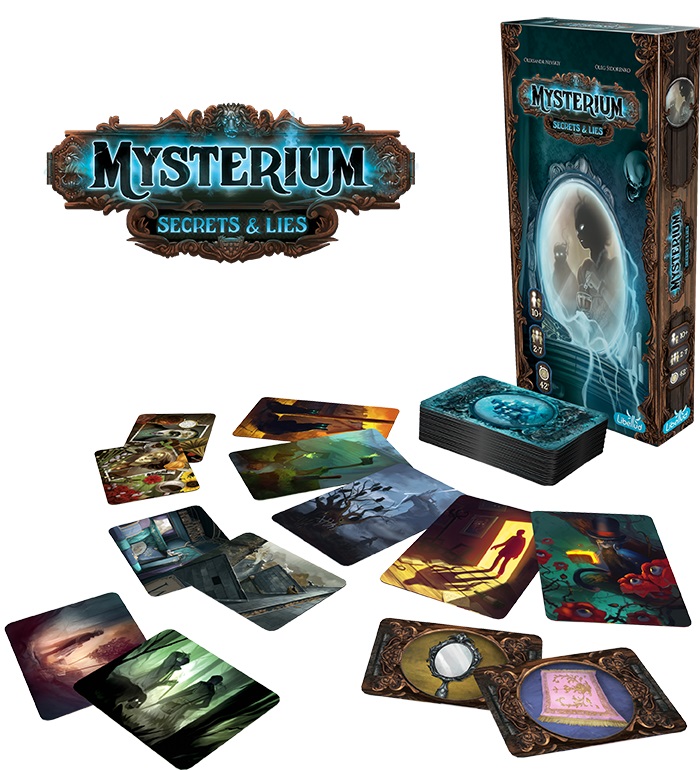
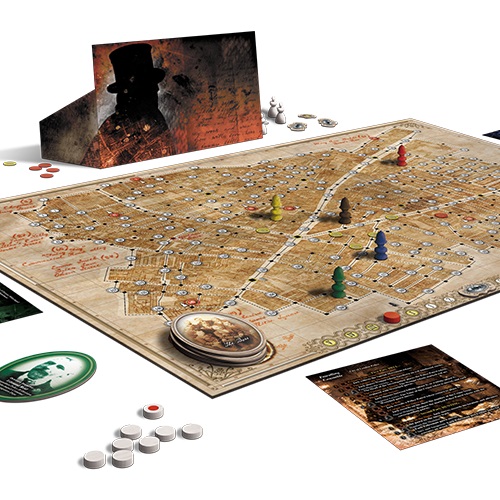

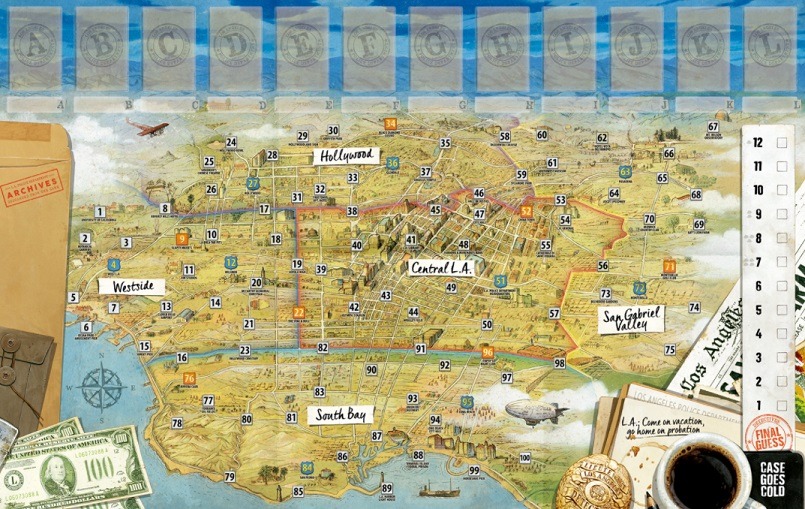

Never played any detective board games before but I have played a number of them on my phone because there seem to be more evidence games like that on my app store.
I think trying out Sherlock Holmes will be a very good idea for me because I have always loved the movie and the books about the legendary detective. Nice list.
If you loved Sherlock Holmes books, then you will love Sherlock Holmes Consulting Detective as well. The style of writing is similar, as are the methods of case-solving, attention to detail and the overall atmosphere. A fine choice.
I have roommates moving into the home soon and I don’t want us to just be bored out of our minds when they come in. This is seriously a perfect gift from the internet haha. Thank you so much for all these options on detective board game, this will be great for my new roommates and I. We will be having a blast!
You’re welcome. Which game are you aiming to get if I may ask?